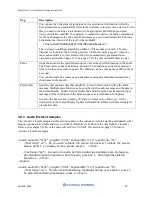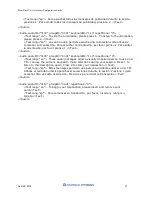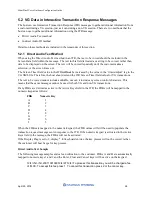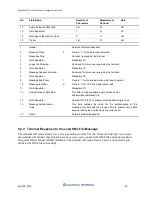
MoniPlus2 Voice Guidance Configuration Guide
April 29, 2014
15
Tag
Values
Description
32
ASCII 2
33
ASCII 3
34
ASCII 4
35
ASCII 5
36
ASCII 6
37
ASCII 7
38
ASCII 8
39
ASCII 9
F1
Enter
F2
Cancel
F3
FDK D
F4
FDK C
F5
FDK B
F6
FDK A
F7
FDK F
F8
FKD G
F9
FDK H
FA
FDK I
FF
Clear
4.6.2 <Keyboard> Element Sample
The following sample defines the keyboard mapping for two FDK layouts. The first is for a screen with
two FDK selections (FDKs C and D).
<Keyboard keyboardID="110" groupID=”0001”>
<Key pos="1" code="F4"/> (maps FDK C to key 1)
<Key pos="2" code="F3"/> (maps FDK D to key 2)
</Keyboard>
This second keyboard mapping layout is for a screen that has all eight FDKs populated.
<Keyboard keyboardID="120" groupID=”0001”>
<Key pos="1" code="F6"/> (maps FDK A to key 1)
<Key pos="2" code="F5"/> (maps FDK B to key 2)
<Key pos="3" code="F4"/> (maps FDK C to key 3)
<Key pos="5" code="F3"/> (maps FDK D to key 5)
<Key pos="6" code="F7"/> (maps FDK F to key 6)
<Key pos="7" code="F8"/> (maps FDK G to key 7)
<Key pos="9" code="F9"/> (maps FDK H to key 9)
<Key pos="10" code="FA"/>(maps FDK I to key 10)
</Keyboard>
4.7 <Audio> Element
<Audio> elements define the text that will be voiced for the screens and parameters that control options
available to the customer when the text is spoken. Options exist within the audio elements to support
nested screens and variable data, if required.
Each screen that can be displayed to a customer should have an audio element associated with it.
















































